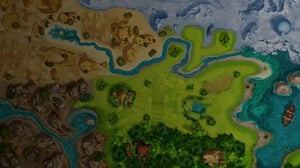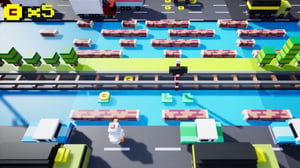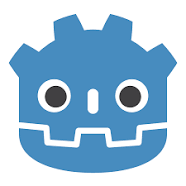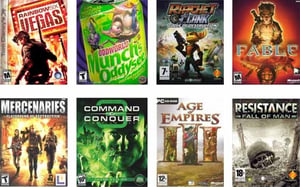
Level Designer
TABLE OF CONTENTS
What does a level designer do?
A Level designer is part artist, part game designer, part storyteller, and part engineer. They put the vision of the game and assemble the world in which the game exists, together.
Level Design, a specialization of game design, focuses on the creation and practical implementation of levels, environments, stories, and quests while considering flow, pace, and space (e.g., ensuring that if players fall out of bounds they don’t get stuck). A Level Designer also creates each level's entry and exit points and guides the player logically through the game via its rules, rewards, and objectives.
Level designers take inspiration from concept art, photo reference, and game design documents (GDD) to sketch believable maps and create physical models of levels. Level design begins early in the game development process as it is the basic structure of the game, with gameplay refinement, inter-level consistency, and user experience driving the development process.
Level designer job description
A Level Designer's role is to keep the player focused on moving through the game and achieving their goal or mission while reducing the potential for confusion.
The sequence of levels is also taken into consideration by Level Designers. The first level of a game will introduce the player to the game. It will establish characters, explain the storyline, instruct the player on the objectives of the game, and generally initiate the player into the world of the game. Each level that follows will then act to further the story, develop characters, increase the level of complexity, up the stakes, and draw the player further into the game.
Level design should not be confused with level creation, which is an environment artist's role; they create the 3D game environment and then Level Designers create game scenarios based on this, such as placing enemies, loot, secret trapdoors, configuring mission parameters, AI patrols routes, NPC positions, etc.
Role & responsibilities of a video game level designer:
- Create level layouts, hot spots, and points of interest (POIs) for players to explore according to the themes and lores of the game
- Iterate your levels through the full cycle of production from conception to finalization, maintaining and balancing the readability, difficulty, and accessibility of the levels for a positive player experience
- Prototype the environment, establish the layouts, and suggest ways of using the interactive and non-interactive elements to create the desired emotions
- As the project progresses, integrate the elements produced on the map (new gameplay, AI, sound, etc.)
- Develop solid design documentation for level progression (flow), layouts, and 3D block-outs for in-engine playtesting

How much does a level designer make?
To learn more about this field, visit: The Game Development Process: How Video Games are Made
In the US, average wages for the video game Industry are as follows:
Skills required to become a level designer
Good Level Designers need a high level of creativity. They don’t need to be super technical, but this role does require a good understanding of some of the basic aspects of technical game development and game programming.
Employers may look for the following skills in a level designer:
- Possess a great understanding of game levels, level layouts, drawing maps, architecture, and other design areas related to game level design
- Strong ability to use puzzles and gameplay to create interesting narratives
- Have a good understanding of technical implementation within games, scripting languages, syntax, and other basic programming concepts
- Basic to advanced drawing skills to communicate ideas visually
- Basic understanding of 3D art, modeling, texturing, rigging, animation, and other areas of 3D art creation, use, and conversion
- Basic to advanced knowledge of Interface design and UI/UX in game system
What software and tools do level designers use?
Level Designers use a broad variety of resources that reflects their variety of responsibilities. They will work with graphics, 2D and 3D animation software, game engines, and programming languages throughout the game development process.
- Scripting Languages & Tools (Python, LUA, C#, Unreal Script, Blueprints)
- Programming languages C++ and Python are also commonly used
Level Designers may need knowledge of a combination of the following software:

Unreal Engine is a 3D computer graphics game engine developed by Epic Games, first showcased in the 1998 first-person shooter video game Unreal

Adobe Photoshop is a raster graphics editor developed and published by Adobe for Windows and macOS. It was created in 1987 by Thomas and John Knoll

Adobe Illustrator is a vector graphics editor and design software developed and marketed by Adobe

Unity is a cross-platform game engine developed by Unity Technologies, first announced and released in June 2005 at Apple Worldwide Developers Conference

Godot is a cross-platform, free and open-source game engine released under the permissive MIT license
How to become a level designer
Here are some sure-fire strategies and career paths to help increase your chances of getting a job in game development.
Get the skills
Look at game studio job ads to see the skills they’re hiring for. Then build those skills: download and learn relevant software, watch online tutorials, or enroll in an industry-focused course.
Stay ahead of trends
Seek out online tutorials, webinars, conferences, publications, and other game programming content to remain informed. See our resource section.
Create your own games
A great way to understand the rigors of game dev and showcase your talent and basic grasp of game production for potential recruiters.
Participate in game jams
A team challenge to produce a game in 24–72 hours, with participants taking on various roles. Gain experience, collaborate, and work towards a deadline. Use the final product in your reel.
Engage with communities
Building connections is vital to getting your name and skills recognized, and a chance to interact with industry pros who can offer advice or even jobs.
Intern at a game studio
Not always a viable option, but it can be a great way of gaining hands-on experience while also networking.
Where to find game design internships:
- 2K
2k.com/en-US/jobs - ACTIVISION
careers.activision.com/students - BANDAI NAMCO
bandainamcoent.com/careers - BLIZZARD
careers.blizzard.com/global/en/internships - EA
ea.com/careers/interns-and-university-graduates - EPIC GAMES
epicgames.com/site/en-US/earlycareers - FAST TRAVEL GAMES careers.fasttravelgames.com/#jobs
- IO INTERACTIVE
ioi.dk/careers - MICROSOFT
careers.microsoft.com/us/en/gamingjobs
- ORBITAL KNIGHT
orbitalknight.com/careers - RIOT GAMES
riotgames.com/en/university-programs - ROBLOX
careers.roblox.com - ROCKSTAR GAMES
rockstargames.com/careers - RESPAWN ENTERTAINMENT
respawn.com/internships - ROVIO
rovio.com/interns - SEGA
recruit.sega.jp/en/internship - SUPERCELL
supercell.com/en/careers - THE FARM 51
thefarm51.com/eng/careers

Ready to Start Your Film & Games Journey?
Download our course guide to see how we can help you on your pathway to your dream career.Tips to break into the game development industry
Use the networking opportunities available to programmers and game devs to build up your contacts. This can be one of the best ways to get a job. Searching online, you can find many industry meetups and events, which often include guest speakers like professional artists and software creators. The knowledge gained by listening to these types of guest speakers talk about their personal experiences is irreplaceable.
Don't for get to check out our interview with Ubisoft AI programmer Firas Hosn.
Get a QA job
Kick-start your career with a job in Quality Assurance. Expand your gaming knowledge by testing and pushing in-production games to their limits.
Collaborate with peers
Working with your peers is fun, you can learn from each other and tackle bigger projects.

Industry Pathways
Troy Dunniway, Game Design Department Head at CG Spectrum, shares why game design is the perfect career for people who are continuously curious and are looking for a way to merge all their interests together, in a balance between the technical and the artistic. Plus, find out what a day in the life of a Level Designer looks like!


